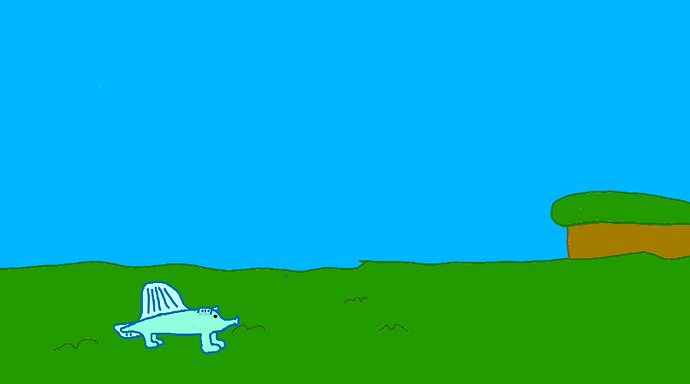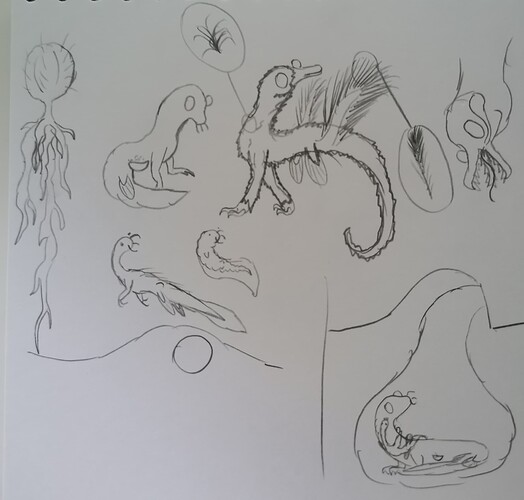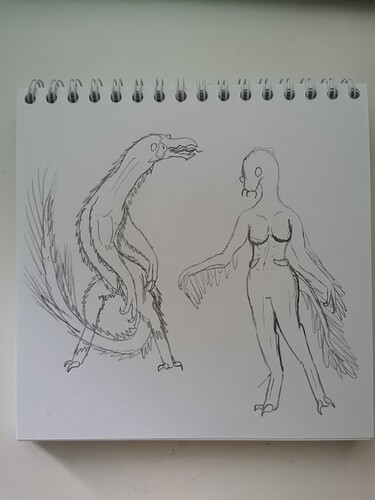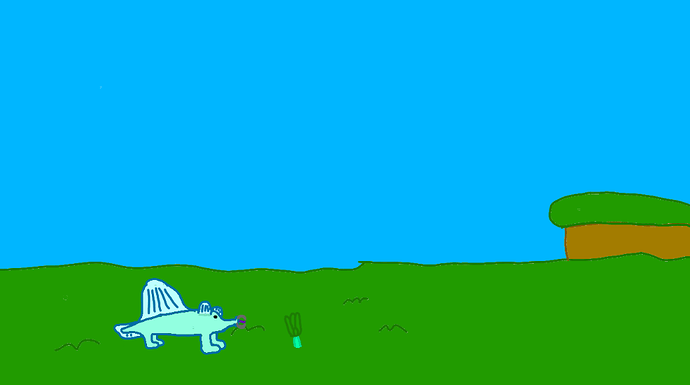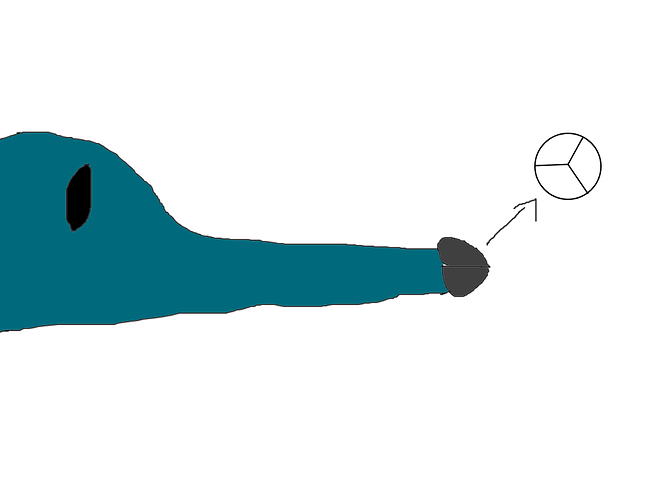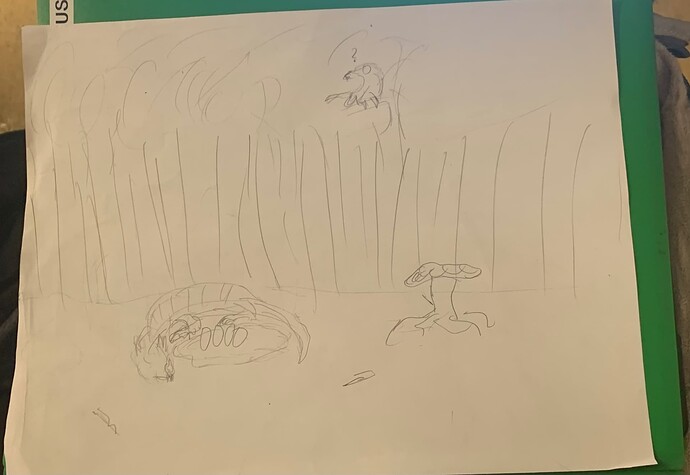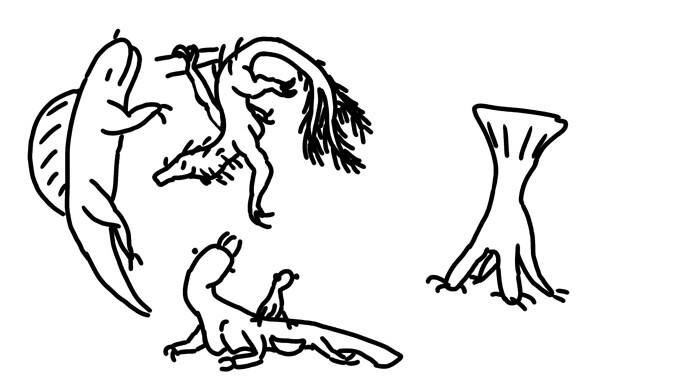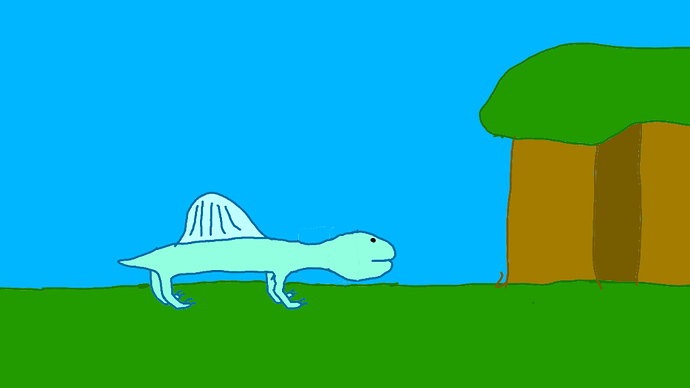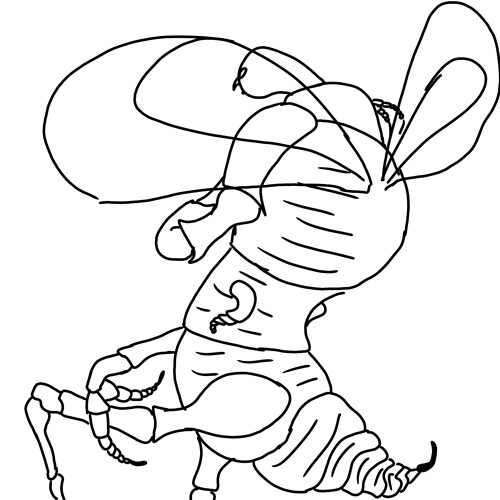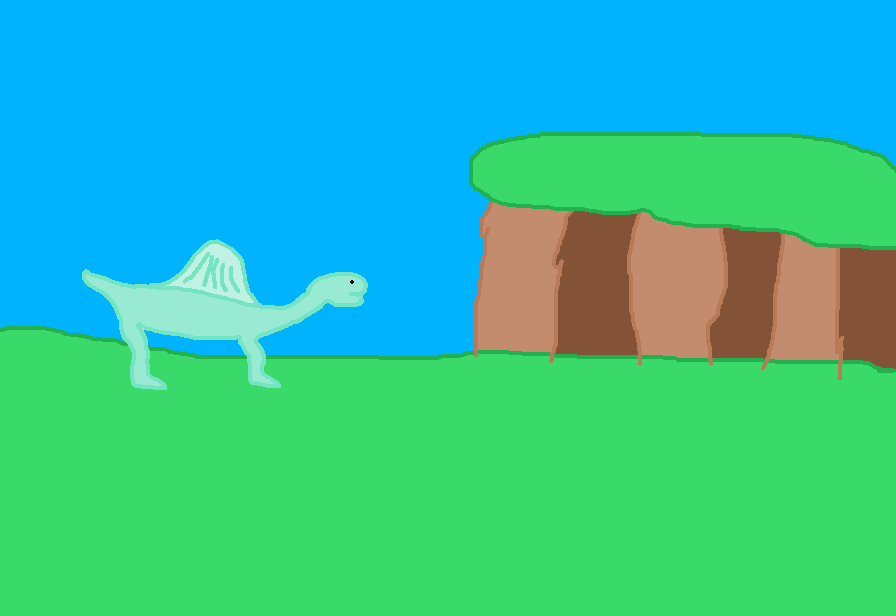I mean, it was always going in that direction
tilephono ekonas could work?
And now we are developing Flumophora separately, as a sister taxon? It seems to me that we are now accidentally building an entire ecosystem. I believe that Flumophora are predators that do not kill the victim, but simply arrange bloodletting for her, accumulating blood in the same organ where food for cubs is stored in females, eating various plants, Flumophora will turn this blood into a nutritious cocktail that can share with cubs after they leave the egg bag, or with other members of the species. Due to the increase in temperature, leading to a reduction in the population, monogamy develops, and females stop eating males. Mating dances are undergoing changes, now the male’s genitals are visible only during mating, so as not to damage them. Both males and females begin to return to this barely noticeable fins left over from the time of their aquatic life. The tail of males becomes bare, and the eyes increase due to the transition to a nocturnal lifestyle. From this point on, females lead an almost completely recumbent lifestyle, all the time being in an underground nest, and constantly mating with a partner, also protecting children. Over time, the protective function of the female’s mouth makes it impossible for her to feed the children, and from that moment on, both the female and the cubs are fed by the male, who goes outside at night to drink the blood of a sleeping animal and eat many plants. After the female and offspring are fed, the male regurgitates the remainder into his mouth, after which he sends it to the real stomach. The male oral apparatus, previously simply represented by three fangs, now acquires soft tissues around the canine, which acquires outgrowths with which the male clings very tightly to the prey. In order not to wake the one whose blood he drinks, his extraorbital glands form, secreting a substance that prevents blood from clotting, and also works like anesthesia. The forelimbs of the male become very convenient for digging holes, and at this time he relies on his newly developing fins (which, I remind you, did not come from the air, just being under the skin before). Their metabolism is accelerating, and they themselves move to semi-deserts, which are full of plants filled with water from the inside, which at the same time have thorns. Males easily cope with this, simply crushing them with fangs, and then sucking up the liquid. After that, the water mixes with blood in the false stomach, and is also used to maintain the life of the offspring. Males have a long proboscis in their mouths, with the help of which they suck blood from animals. Males develop an insulating cover similar to downy feathers of birds, while females get by with an abundant fat reserve, mainly in the tail, egg bag, pectoral muscles and at the base of the fins. At night, the female closes the egg bags and curls up around the already relatively adult cubs in order to warm them with her body, as a rule, by the time they leave the mother’s egg bag, only one or two cubs remain per bag, the rest become food for them. The male heats up due to endothermy and his integuments. Extra-pouched chicks have no sex, possessing both the rudiments of male feathers and the simple mouth apparatus of the female, their limbs are not yet so clearly differentiated. Over time, depending on the time of year, the oldest chicks become either males (cold) or females (warm), and after that they leave to build their nest, moving in pairs (if they meet another pair, the males change females, at that moment still covered feathers and capable of active locomotion and hunting, but if this does not happen before coming to a reservoir (near which they gain strength before building a nest), the male mates with the female right at the watering hole and they build a new nest nearby). As a result, the cycle is repeated. By the way, younger males are excited by the presence of more fat at the base of the fins and in the area of the pectoral muscles of females, and older ones simply constantly mate with their female (monogamy), while not disdaining to look at another female on one of the outings for food and mate with her, and the females don’t even mind.
It could bleed into a vampire race like this in the far future, but that would be too cliché, so I don’t know why I drew it at all. ![]()
Maybe, don’t make it as humanoid, you wouldn’t have that problem then
So I said that I abandoned this idea, so they will remain bloodsuckers to the very end, since they have already adapted too well to this. What, Google translator failed to translate from Russian, that I abandoned this idea? It’s just that our language is quite complex in terms of logic, only floating grammar (words can be in ANY order) is worth it, because of it it can confuse questions with statements. In any case, I abandoned the idea of making them humanoids, but the female in a near-Davidian pose brings me aesthetic pleasure.
Hehehehe
Anyway, FOREST FISH-BIRDS !!!
I suggest in the main post to write a list of species, namely:
- Tilephono Econas
- Flumophora Ordinaris🇷🇺
- Some kind of tree
- Some parasite of some tree
![]()
Flish from “The Future Is wild”?!
Seriously though, my username refers to one of the animals from this movie just because it’s funny. True, in the end, the swampuses were reworked into reasonable corvids, but that’s not the point
- Tilephono Econas
- Flumophora Ordinaris
- Normal trees (background)
- A invasive tree (mushroom-like sprout)
- ?!?!?
Yeah i did this in a hurry. Claswork.
We’re far from the shallows now. Tilephono has grown to care for their young in primitive nests. Flumpphora are screwing around in the canopy when not mating. But there are threats to both. An invasive species of tree from another continent, and the flying, creepy, huge buzzers that brought the formers’s seeds here.
I’ll let you imagine number 5. It’s insectoid ![]()
Damn Flumophor is so cute here ![]() Well, yes, this is a stylized fauna of the planet, Flumophor turns the fins into limbs, and the “wings” of males go to the tail, also, their forelimbs adapt to climb trees and grab branches, thereby giving males attacking animals harshly and risky from above (for a tilefono that does not have a flexible neck, this is, of course, dangerous, but the Flumophors themselves do not try to kill him, on the contrary, the longer the victim lives, the less energy is spent on food extraction
Well, yes, this is a stylized fauna of the planet, Flumophor turns the fins into limbs, and the “wings” of males go to the tail, also, their forelimbs adapt to climb trees and grab branches, thereby giving males attacking animals harshly and risky from above (for a tilefono that does not have a flexible neck, this is, of course, dangerous, but the Flumophors themselves do not try to kill him, on the contrary, the longer the victim lives, the less energy is spent on food extraction
(post deleted by author)
is someone looking at this?
